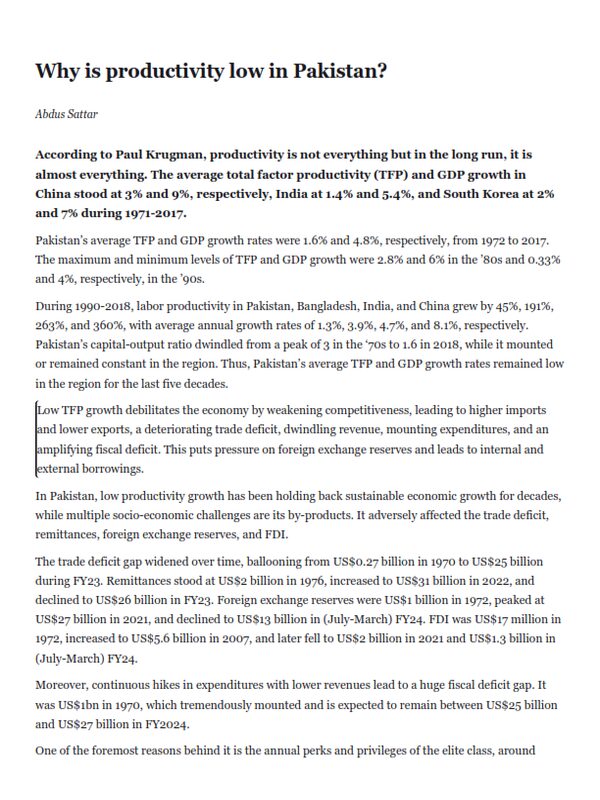Why is productivity low in Pakistan?
According to Paul Krugman, productivity is not everything but in the long run, it is almost everything. The average total factor productivity (TFP) and GDP growth in China stood at 3% and 9%, respectively, India at 1.4% and 5.4%, and South Korea at 2% and 7% during 1971-2017.
Pakistan’s average TFP and GDP growth rates were 1.6% and 4.8%, respectively, from 1972 to 2017. The maximum and minimum levels of TFP and GDP growth were 2.8% and 6% in the ’80s and 0.33% and 4%, respectively, in the ’90s.
During 1990-2018, labor productivity in Pakistan, Bangladesh, India, and China grew by 45%, 191%, 263%, and 360%, with average annual growth rates of 1.3%, 3.9%, 4.7%, and 8.1%, respectively. Pakistan’s capital-output ratio dwindled from a peak of 3 in the ‘70s to 1.6 in 2018, while it mounted or remained constant in the region. Thus, Pakistan’s average TFP and GDP growth rates remained low in the region for the last five decades.
Low TFP growth debilitates the economy by weakening competitiveness, leading to higher imports and lower exports, a deteriorating trade deficit, dwindling revenue, mounting expenditures, and an amplifying fiscal deficit. This puts pressure on foreign exchange reserves and leads to internal and external borrowings.
In Pakistan, low productivity growth has been holding back sustainable economic growth for decades, while multiple socio-economic challenges are its by-products. It adversely affected the trade deficit, remittances, foreign exchange reserves, and FDI.
The trade deficit gap widened over time, ballooning from US$0.27 billion in 1970 to US$25 billion during FY23. Remittances stood at US$2 billion in 1976, increased to US$31 billion in 2022, and declined to US$26 billion in FY23. Foreign exchange reserves were US$1 billion in 1972, peaked at US$27 billion in 2021, and declined to US$13 billion in (July-March) FY24. FDI was US$17 million in 1972, increased to US$5.6 billion in 2007, and later fell to US$2 billion in 2021 and US$1.3 billion in (July-March) FY24.
Moreover, continuous hikes in expenditures with lower revenues lead to a huge fiscal deficit gap. It was US$1bn in 1970, which tremendously mounted and is expected to remain between US$25 billion and US$27 billion in FY2024.
One of the foremost reasons behind it is the annual perks and privileges of the elite class, around US$17.4 billion, being paid from taxpayers’ money. The shrinking middle class, from 42% to 33%, is always sacrificed in the form of higher taxes and inflation of 17.4%, while 40% of the public lives below the poverty line.
Pakistan’s economy shifted to the path of internal and external borrowings to cope with the fiscal deficit over time. The total public and external debt stood at US$239 billion and US$131.6 billion, respectively, in 2023.
External debt servicing was about US$3.4 billion during the 1970s, increased to US$10 billion in 2020, US$15 billion in 2022, and is expected to reach US$27 billion from Jan 2024 to Dec 2025. The severity of dependence on the IMF is obvious from the uncertainty regarding the tranche of US$1.1 billion in 2023, which shook the economy. Pakistan is stuck in a debt sludge, taking more loans to pay the interest on old loans, with more than 60% to 70% of public revenue going into debt servicing.
So how can Pakistan get rid of such economic problems? Research and Development (R&D) can trigger innovation and inventions – US$1 invested in R&D brings US$2 in return. Innovations and inventions through R&D have played a decisive role in enhancing TFP growth.
Global R&D expenditure has grown from US$675 billion to US$2.4 trillion over the last two decades. The USA, China, and Japan spent US$721 billion, US$583 billion, and US$174 billion, respectively, in 2020. Pakistan’s R&D expenditures were only 0.20% of GDP compared to China (2.4%), India (0.8%), and Bangladesh (0.30%).
It is worth noting that India’s current science and technology budget is about US$2 billion, a hundred times more than Pakistan’s science and technology budget (US$0.02 billion). In HDI rankings, Bangladesh, India, and Pakistan were ranked 126, 132, and 161 out of 192 countries in 2021-22, and currently, Pakistan stands at 164 in 2023-24. Due to low R&D expenditure, according to the Global Innovation Index, Pakistan ranked 87th, while China (11), India (40), and Bangladesh (102) were among 132 countries in 2022.
It is observed that in emerging and advanced economies, R&D expenditures remained at more than 3% of GDP. TFP growth of more than 3% can bring a sustainable GDP growth rate of more than 8%. R&D remained the least important subject in Pakistan for decades. The lack of R&D opportunities and fewer expenditures on innovation and invention caused the lowest TFP growth in the long run in Pakistan.
Elites’ perks and privileges of US$17.4bn should be eliminated. Foreign loans are not a long-term remedy to resolve Pakistan’s economic issues. The long-run solution lies in enhancing TFP growth. Resources should be shifted towards physical infrastructure and human resource development.
More technical, skilled workers in science and technology (S&T) and IT professionals are needed to enhance TFP growth. Long-run investment is needed in innovation and inventions in S&T. R&D expenditures should be raised to 3% of GDP.
This will increase TFP and GDP growth by 3% and 8%, respectively. It will also fuel export-led growth, improve trade and fiscal balances, and enhance remittances, FDI, and foreign exchange reserves. Ultimately, reliance on foreign loans will diminish in the long run. This dream will come true through peace, political stability, continuity, and consistency of policy and reforms.
Copyright Business Recorder, 2024




